In this short sewing basics video, we show you how to use a bamboo point turner. If you think this tool is only used for one thing, think again! See what else it can do and why you need it in your sewing space.
~Sheryl Belson
In this short sewing basics video, we show you how to use a bamboo point turner. If you think this tool is only used for one thing, think again! See what else it can do and why you need it in your sewing space.
~Sheryl Belson
What is a languishing sewjo you ask? I recently read articles in both the New York Times and NPR about this new condition. It’s apparently a real thing that isn’t depression but is a lingering state of “meh.” When I read it, I immediately thought – YES! This validates what I have been feeling!
My sewing room has been largely silent the past year. I just haven’t been able to muster up the enthusiasm and sense of sewing adventure I have come to enjoy for so many years. Where did it go? I have forced myself through making a shirt, a dress, and a quilt top since June 2020 — only 3 projects in the past year! I have been seeing reports of so many of our members sewing up a storm during their COVID quarantine life and, honestly, I have responded with mixed feelings of jealousy and guilt. I have wondered what is wrong with me.
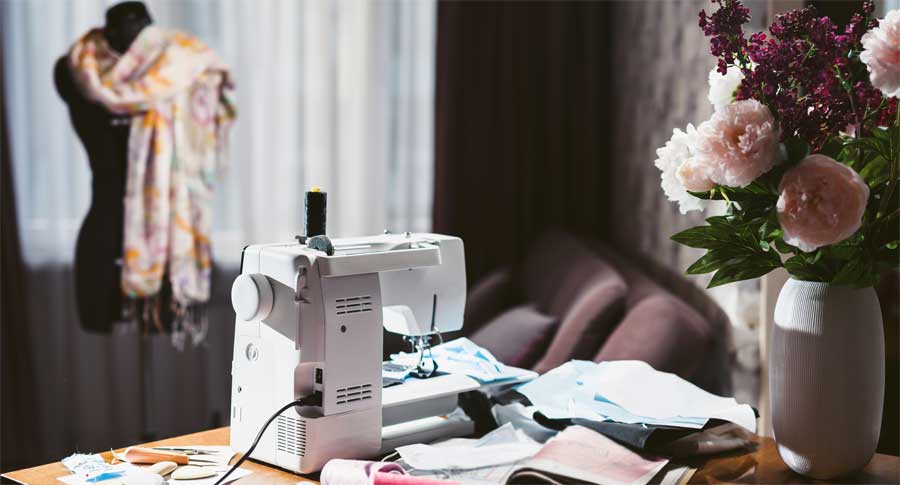
Life changed for everyone this past year. While my details differ from yours, the element of changed life is common to all. My husband recently commented that he hopes I get back to sewing one day. Ouch! That felt like a punch in the gut. Don’t get me wrong, my husband is my biggest fan and supporter so I wasn’t offended, but the reality of his statement is what punched my gut.
Clearly, I am a work in progress so I can’t title this part as 5 steps to an Exciting Sewing Life. Instead, I can share where my journey is taking me.
 I decided to take a few steps that I hope will re-ignite the enthusiastic passion I have felt for sewing and that I miss and started exploring some new sewing adventures. For years I have loved being almost exclusively a garment sewist. Since pandemic quarantine life, I can’t seem to get excited about making clothes, so I’m going to try a few different things.
I decided to take a few steps that I hope will re-ignite the enthusiastic passion I have felt for sewing and that I miss and started exploring some new sewing adventures. For years I have loved being almost exclusively a garment sewist. Since pandemic quarantine life, I can’t seem to get excited about making clothes, so I’m going to try a few different things.
 I also decided to make a few sewing appointments with myself. If I schedule some time to dedicate to this craft I have loved so much, I am bound to experience those dopamine hits it has given me all those times before. But I have also promised myself a lot of grace as I reclaim what feels a little bit lost at the moment. No more jealousy — just appreciation for what others create. No more guilt — just patience as I explore what sewing adventures await while I gently reacquainted myself with my sewing room.
I also decided to make a few sewing appointments with myself. If I schedule some time to dedicate to this craft I have loved so much, I am bound to experience those dopamine hits it has given me all those times before. But I have also promised myself a lot of grace as I reclaim what feels a little bit lost at the moment. No more jealousy — just appreciation for what others create. No more guilt — just patience as I explore what sewing adventures await while I gently reacquainted myself with my sewing room.
If the past year has been a season of incredible sewing, I salute you and appreciate what you have shown and shared. It has reminded me of all the possibilities! But if you slipped into a languishing sewjo as I did, I hope sharing my reality has given you space to think about how you might head back to your sewing room and reclaim the passion for sewing we have all shared. I can’t wait to see where we go!
~Sheryl Belson
It’s National Sewing Machine Day! Spend 17 minutes with us in this video and learn about 6 different parts of your sewing machine. Want to learn more? If you aren’t a member already, we hope you’ll consider joining ASG — we would love to meet and sew with you!
~Sheryl Belson
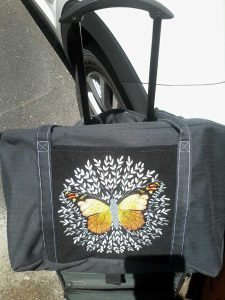 After being cooped up at home for over a year, everyone is anxious to travel again, even homebodies like me. In anticipation of an in-person ASG conference, I decided to make a luggage tote that fits on the handle of my rolling suitcase. To get exactly what I wanted, I made my own pattern for this project which was quick and easy—just perfect for me. I especially like the boxed ends and the simplicity of how it could be achieved. I’m including my own instructions below, but if you prefer a commercial pattern, one of my favorite conference instructors, Linda McGehee from Ghee’s, has the L-Bag pattern with multiple sizing, helpful tips, and excellent instructions. While there, also check out the variety of novelty zippers she sells that make the bag really pop.
After being cooped up at home for over a year, everyone is anxious to travel again, even homebodies like me. In anticipation of an in-person ASG conference, I decided to make a luggage tote that fits on the handle of my rolling suitcase. To get exactly what I wanted, I made my own pattern for this project which was quick and easy—just perfect for me. I especially like the boxed ends and the simplicity of how it could be achieved. I’m including my own instructions below, but if you prefer a commercial pattern, one of my favorite conference instructors, Linda McGehee from Ghee’s, has the L-Bag pattern with multiple sizing, helpful tips, and excellent instructions. While there, also check out the variety of novelty zippers she sells that make the bag really pop.
Luggage Tote Instructions (pdf)
For this project, I used 4 sheets of 8.5 x 11 copy paper to make the pattern, and included a sleeve on one side to slide over the handle of my luggage. Although there is basic geometry involved in the design, making the pattern required no measuring or angles to calculate, just simple paper folding.
I chose a heavy-weight home-dec fabric that I had in my collection for the bag. The right side of the fabric felt like a medium-weight denim, and the wrong side had a rubberized backing. While it appeared strong and durable and did not require lining, it was also sturdy enough to support the contents of a packed bag while still remaining flexible to stuff under an airplane seat.
I added an embroidered pocket on one side of the bag that was held in place by the handle straps that go up the sides of the bag. The pocket design was a Monarch butterfly from Embroidery Library. For the sleeve that slips over the luggage handle, I included a zipper on the outside of the sleeve, with a solid piece of fabric for the back side. This created an additional zippered pocket for more security. Free standing 3D butterflies were used on the sleeve and were made with a butterfly design from my Brother embroidery machine that was stitched on using a double layer of mylar with a heavier cutaway stabilizer sandwiched between the layers of mylar. This provided enough stiffness that the butterflies could be bent slightly to give the 3D effect. The butterflies were cut close to the stitching, leaving an ever so slight margin of mylar, then were securely hand-stitched to the outside of the sleeve pocket by going around the stitches of the body (and not the wings). The technique would not withstand the abuse of luggage handlers, but is fine for a carry-on.
Webbing is the best choice for handles, but with none available at midnight when I wanted to sew, I made the handles from the bag fabric. It ended up a little too thick for my liking, so future bags will be made with the webbing. Sewing through the 4 layers of the handle, the double layers of the pocket, plus the side of the bag did not make my trusty old Singer happy. It plowed through, but not without a few complaints. I used webbing for the second tote.
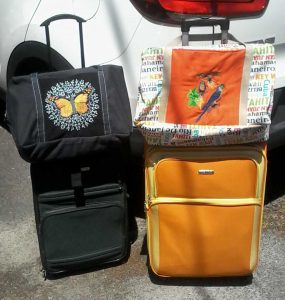 I love the design of this bag! It is streamlined for getting those flat, squared ends of the bag perfect every time. Excluding the embroidery and the fabric handles, the entire bag can be constructed in about an hour. And while it makes for a great travel bag, it also works well for carrying sewing supplies to retreats, meetings, or anytime more space is needed than my trusty purse provides. I hope you will give this one a try.
I love the design of this bag! It is streamlined for getting those flat, squared ends of the bag perfect every time. Excluding the embroidery and the fabric handles, the entire bag can be constructed in about an hour. And while it makes for a great travel bag, it also works well for carrying sewing supplies to retreats, meetings, or anytime more space is needed than my trusty purse provides. I hope you will give this one a try.
~Rosemary Fajgier
Selvages are the edges of woven fabrics—the place where the weft (crosswise) threads turn around to form the next row during the weaving process. Some selvages are thicker than the fabric itself, as often there are more threads per inch at the edges to help keep the edges straight during the weaving process.

Selvages may be the same color as the fabric, or they may be a contrast. Interestingly, contrast threads are sometimes woven in the selvages. On some velvets and velveteens, you may see metallic threads along the edges.
On high quality and imported fabrics, sometimes the requisite information like fiber content and country of origin is actually woven into the selvage in a contrasting thread color.
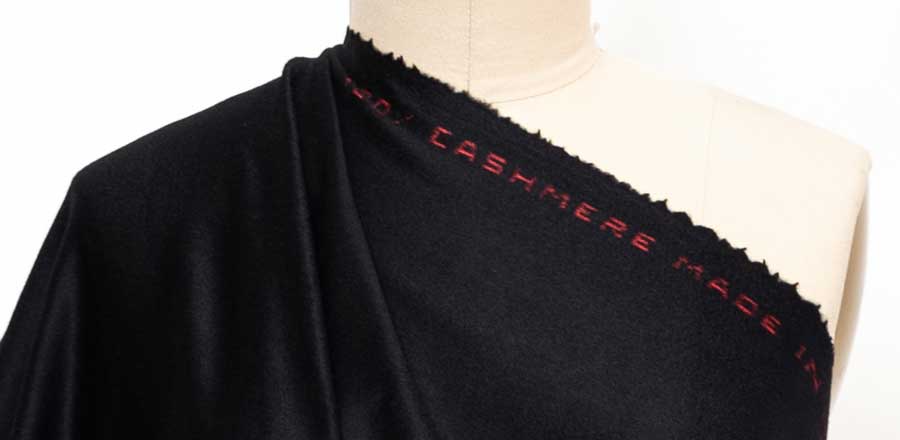
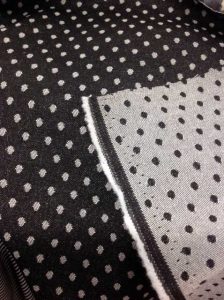 Selvages are not always straight—they can be fringed or looped, depending on the type of loom used and the finishing processes.
Selvages are not always straight—they can be fringed or looped, depending on the type of loom used and the finishing processes.
On fabric like denim where the warp (lengthwise) threads are a different color than the crosswise threads, the selvages may be totally different looking than the fabric body itself.
You can find a variety of information bits on most selvages, but some have none. Look for the brand name, the designer’s name and sometimes the fiber content and/or care instructions, like “dry clean only.” You may also find the date the fabric design was copyrighted, and on printed fabrics, you may see lots of colored dots or shapes along the edge. These fun indicators tell how many different color screens were used in the printing process of the particular fabric.
Because of their tighter weave, the selvages may shrink differently from the fabric itself, so many people just cut the selvages off before cutting out the project.
While you can certainly trim and toss them, you can also use them creatively. If your project has a straight seam edge, you can cut it on the selvage to avoid raveling and perhaps add a decorative touch to the seam edge. A pant leg seam or a loose fitting, straight-cut jacket would be two great places to cut on the selvage for pre-finished seam allowances. Selvages are also a great edge for pockets or straight hems, either exposed for interest, or just as an edge finish.
Trimmed selvages are often used to stabilize a stretchy area—like a shoulder seam in a knit T-shirt. Lightweight woven selvages, like silk organza, are ideal for this use, as they’re sheer and don’t add a lot of bulk as they span the seamline. Interesting cut-off selvages can also be “reapplied” to an area as a decorative trim, often combined with ribbons, braids or decorative stitching. Fun selvages are also great to insert as a flat piping.
Selvages (with some attached fabric width) can also be used for bindings or garment ties.
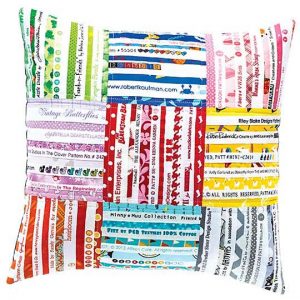
If you’re a quilter, perhaps you keep all your cotton selvages for other projects. It’s easy to strip piece them together on a lightweight backing to make quilt blocks or other projects. When you trim the selvage, leave at least ¼” beyond the actual selvage and use that for joining. Layer the strips one edge over the other and zigzag the edges in place through the backing until you fill the space needed.
For crafting, trimmed selvages are ideal for decoupaging onto projects—like basic tennies {photo}, picture frames, boxes, vases, etc. Just overlap the raw edge portion and seal with the medium.
What are those holes along the selvage? They’re called tenter holes and they’re used to hold the fabric to a frame during the printing and finishing processes.
~Linda Griepentrog
Linda is the owner of G Wiz Creative Services and she does writing, editing and designing for companies in the sewing, crafting and quilting industries. In addition, she escorts fabric shopping tours to Hong Kong. She lives at the Oregon Coast with her husband Keith, and two dogs, Yohnuh and Abby. Contact her at gwizdesigns@aol.com.
American Sewing Guild
National Headquarters
9660 Hillcroft, Suite 230
Houston TX 77096
713-729-3000 | 713-721-9230 Fax
www.ASG.org
